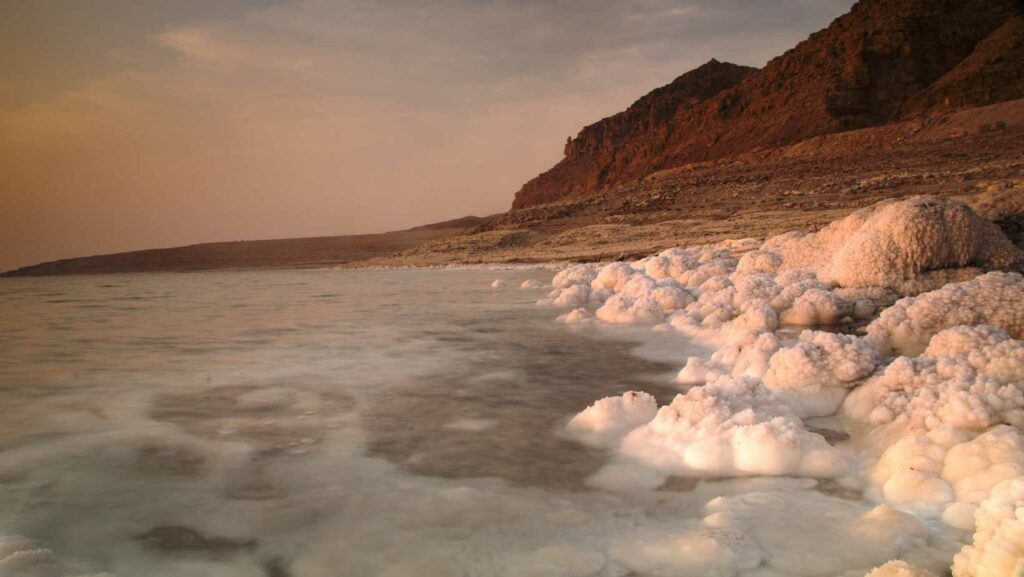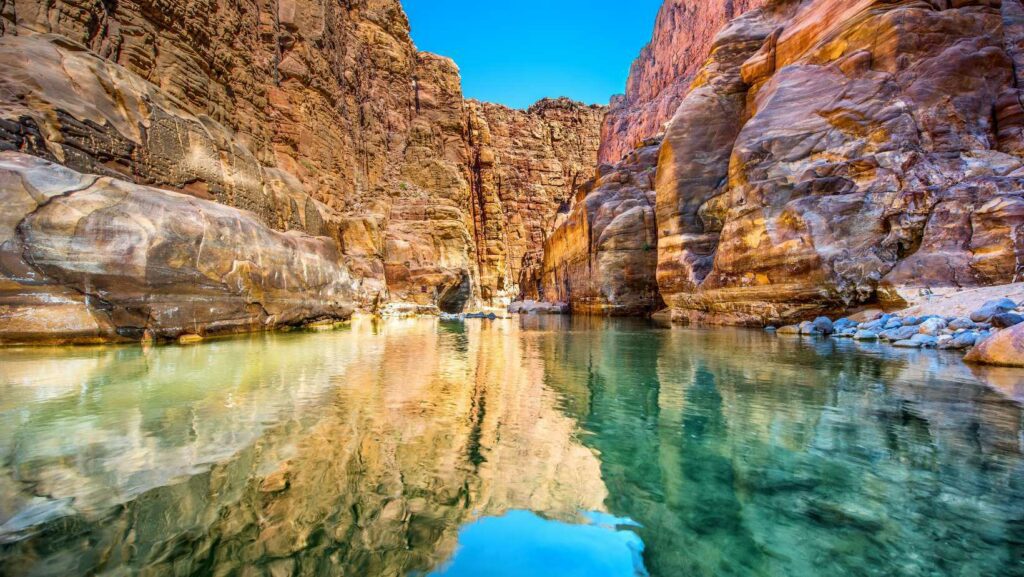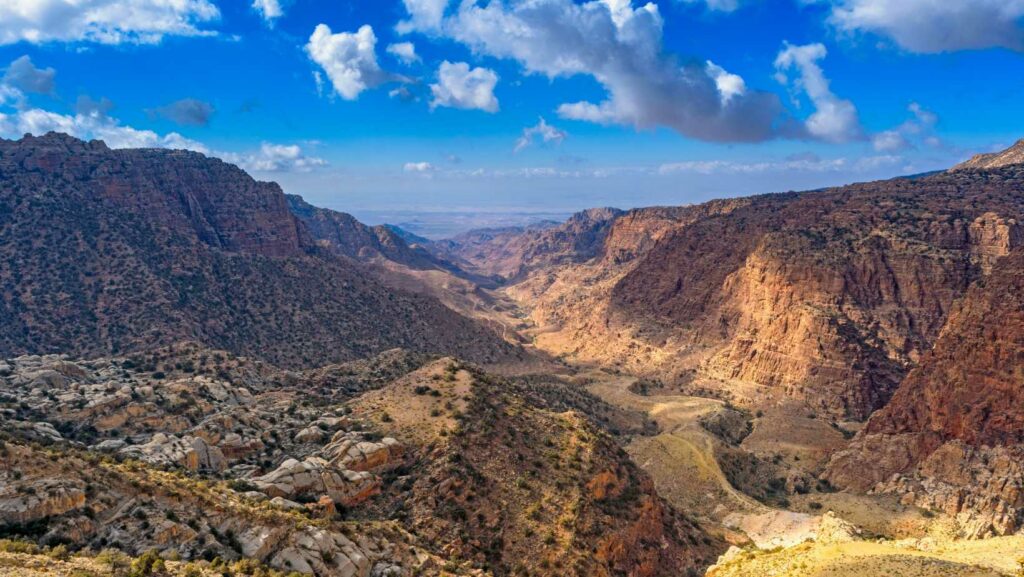It’s been a long time since I took you on a little adventure! And to be honest, a few hours before leaving for this one, the anxiety rose a little! Anxiety and impatience!
The Jordan Trail is a trekking in Jordan, divided in 8 sections from Um Qais to the Red Sea. Below I have described each section and a complete FAQ. (a little bit of vocabulary before starting : you will see the word “wadi” very often : it means valley in Arabic, more specifically dry river beds).
The Jordan Trail
The Jordan Trail is a hiking route that, as its name suggests, is in Jordan. It crosses the country from Um Qais in the north to Aqaba in the south.
It takes 40 days of hiking and over 675 kilometers. On the way, you will cross 75 villages and cities and discover the diversity of its landscapes, Wadi Rum, the Red Sea and the most famous historical monuments of the country such as Petra, Um Qais, Jerash…
The Jordan Trail is therefore a pretty incredible itinerary that allows you not only to hike, but also to discover the history and the culture of this beautiful country.
While some long distance hiking trails are really well known, the Jordan Trail is slowly starting to make a name for itself, served by the beauty of its landscapes and by the growing popularity of Jordan. The Jordan Trail Association was therefore established in July 2015, to manage and develop the trail as well as its maintenance. The association works to improve the accessibility of the Jordan Trail and establish connections between all the actors who help bring it to life. The Jordan Trail facilitates the economic development of local communities by creating jobs, and the economy of the country by creating minimal impact tourism that promotes an outdoor culture and environmental awareness.
Those seeking to create new trails and improve the existing one are assisted by local enthusiasts from each of the trail’s regions. Many Bedouin tribes are helping to develop the sections of the trail between Petra, Wadi Rum and Aqaba, while the sections in the north and around Karak have received endless support and help from local hikers and groups. From north to south, the entire length of the trail is maintained by the tireless efforts of individuals and organizations dedicated to the project.
The Jordan Trail itinerary
Walking from north to south in Jordan is nothing new. For thousands of years, it has been a means of communication, allowing distant people to do business and be connected. Ancient paths and trade routes run through the lands that make up the state of Jordan today. Jordan was the center of the King’s Highway, a trade route that stretched from Egypt to Aqaba and north to Damascus. This route was used by the Moabites, Edomites, and Ammonites, but in the early centuries BC, Nabatean merchants extended this route to Asia and southern Arabia, making Jordan the center of their empire, of which Petra was the jewel. After the reign of the Nabataeans, the Roman Empire kept on using these roads as essential parts of its Middle Eastern road network.

The different parts of the Jordan Trail
My experience will allow you to live with me for a few days in the heart of the Jordan Trail, but it is only a very small part of the whole route. You will find below more details on the different sections of the Jordan Trail.
1 : UM QAIS TO AJLOUN
The hills and valleys of Jordan’s northernmost and greenest region are filled with ruins of many ancient civilizations. The fertile lands, hilltop meadows and pinnacle oak forests of the hot Jordan Valley provide a fascinating natural backdrop for trekking through historic sites that are over 2000 years old. Hot springs, giant ancient olive trees, caves, mysterious prehistoric structures, and Roman towns and villages pioneering community-based tourism are just some of the attractions of this northern tip of Jordan.

2: AJLOUN TO AS-SALT
Descend from the Burma village to the King Talal Dam for views of the vast expanse of water that stretches east through forested banks. Then cross the dam wall, climb a ridge, and continue south past fertile farmland to the mixed Christian-Muslim village of Rmemeen, home to a café and adjacent church tower and minaret. Behind it is a trail through a narrow and winding agricultural valley, climbing near AhliyyaUniversity to reach the city of Salt.
3 : AS-SALT TO WADI ZARQA MA’IN
The route begins in the town of Salt and takes hikers past the ancient Iraq Al-Ameer Palace before descending the spectacular King Hussein Rally Road into the Jordan Valley. The climate and landscape are now changing, becoming warmer and drier, as the trail crosses the rugged plateau overlooking the Dead Sea and passes through dotted Bedouin camps. Here the trail joins the Roman road that connects the northern Dead Sea with the fortress of Mukawir (Machaerus). Along the way, climb a ridge and descend basalt cliffs and the Wadi Zarqa. Hikers then travel north of Mukawir and descend into the deep gorge of Wadi Wala.

4: THREE WADIS TO AL- KARAK
The Wadis to Al Karak region begins at the southern tip of Wadi Wala. From there, hikers will follow the edge of the plateau while getting breathtaking views of Wadi Hidan and Wadi Mujib before descending and crossing Wadi Mujib. The wadi is very wide, 800 meters deep, with a steady stream at the bottom, dottingthe arid landscape with patches of green farmland and the occasional Bedouin tent. After a long climb, the trail heads south over a fertile plateau of rich red soil and farmland, past the ruins of Magdelina on the edge of Wadi ibn Hamad (Nature Reserve), and descends 300 meters into Wadi El Tawahin. Then it climbs again via Wadi ez Zaiyatin to reach Al-Karak’s impressive crusader castle, which towers impressively over the surrounding landscape.

5 : AL-KARAK TO DANA
The Jordan Trail leaves the southern fortress of Al Karak and winds down to a beautiful valley. Perched on a series of cliffs on the other side of the valley is the village of Shehabie, originally named Ifrang by the Crusaders who settled there after the fall of Karak’s castle.
Further down the valley, the hiker reaches the abandoned ancient village of Khirbet Ainun, dramatically situated above the wadi’s bend. In addition, the trail goes up to the fertile plains and then down to Al Iraq, with its orchards and olive groves overlooking Wadi Numeira. The trail then crosses another hill to reach the edge of the imposing Wadi Hasa, where it carves a 1,000meter-deep chasm into the landscape of the southern edge of the Dead Sea. The descent follows a path between the towering limestone cliffs of Thor Al Taboun, zigzags down across wadi beds and up the other side, crossing a Bedouin camp along the way. Back to a plateau again, the trail follows a hilly ridge south through a series of villages east of Tafileh, reaching the Edom ruins of Sela and Mi’tan. After passing the deep Wadi Labun, the trail heads over the next hill to the restored village of Dana. The hotel and campground are on the edge of Wadi Dana on the edge of the RSCN reserve.

DANA TO PETRA
It is certainly one of the most striking parts of this trek, so much so that it was recently named by National Geographic as one of the fifteen best hikes in the world. It must be admitted that few trails can boast of so many varied and breathtaking landscapes, ending in a jewel of history and architecture.
From the mountainous highlands to the Araba Valley and beyond, the trail climbs and descends, letting us discover the full variety of climates, ecosystems and geology of the region in spectacular landscapes of canyons, labyrinths, hills and valleys.
It really is a kaleidoscope of different sights every few kilometres, mountain or countryside, impressive or serene. And as if that were not enough, the route arrives at Petra, the incredible Nabataean masterpiece.
It takes days to discover this city in the rock, the Jordan Trail leads us there but you really have to take the time to linger there to capture all its beauty and history.
7: PETRA TO WADI RUM
Joining two legendary place, Petra and Wadi Rum, it’s a long trek through one of the longest stretches of wilderness on the Jordan Trail. Here in the empty high desert, stargazing is at its best and quiet contemplation comes naturally. This section of the trail begins on a deep, rugged wadi and leads to open sandy plains surrounded by otherworldly sandstone hills. He takes you deep into places people rarely go. Wadi Rum will offer hikers a taste of desert tranquility.
8: WADI RUM TO AQABA
Week 8, the one where you can follow me!
The road south of Wadi Rum passes under the towering cliffs of Jebel Rum and Jebel Um Ishrin, through an area described by T.E Lawrence. Drive between the cliffs of Jebel Khazali and its ancient rock art, and cross Jebel Qattar on a hidden “dripping spring” that still winds among the unique and colorful backdrop of Wadi Rum’s sandstone desert mountains. The trail turns west again, leaving Jebel al Qiddar and its wadi to head west, down Wadi Waraaqa and past a series of reservoirs that line the route to the Bedouin village of Titen.
From Titen the trail follows the old shepherd’s Trail, meandering west through desert wadis and over granite mountains where basalt dykes have collapsed. At the final pass, hikers suddenly get their first glimpse of the Red Sea and the Gulf of Aqaba, with the Sinai Mountains beyond. The descent from the pass descends a long sandy wadi reaching the fascinating warm waters of the Red Sea, the terminus of the Jordan trail between the Saudi Arabia border and the port of Aqaba.
How do I find out about the Jordan Trail?
If you want to hike the Jordan Trail too, visit the website jordantrail.org. It will allow you to plan your hike and discover the different sections. It gathers all the advice and a list of groups and companies proposinghikes on the trail.
My 5 day experience on the Jordan Trail
I am back to civilization after these 5 days spent in the desert of Wadi Rum. A beautiful adventure that allowed me to live my first experience in the desert, to meet beautiful people, to live incredible nights under the stars and of course to discover on the field the organization of the Jordan Trail.
It was one of the first time I went on an organized trek with other people, as I am more used to trekking on my own and I must say that I loved this experience. And especially that it made me want to do the whole Jordan Trail…
Why? I tried to summarize my experience with this top 3 :
The landscapes
It is of course the main asset of this trek, the incredible landscapes of Jordan. I was able to spend 5 days in the desert of Wadi Rum, a unique experience that I highly recommend, and I continued my trip in Jordan to take advantage of this beautiful country.
I exchanged a lot with the “thru hikers”, those who had been on the Jordan Trail since the beginning and who had been criss crossing Jordan for 40 days. All of them were unanimous about the beauty and diversity of the landscapes they encountered.
The Jordan Trail not only allows us to discover unknown nuggets of Jordan but also to go to the “tourist stars” like Petra.
The meetings
Contrary to other treks, the Jordan Trail is still little known and little used. It is therefore more difficult if you want to go alone to meet other hikers. Going with an organization, whether it is the Jordan Trail Association or a licensed group, allows you to be part of a group of international hikers and to share these unique moments together.
But the encounters don’t stop there, because all along the way you are supervised by locals!
The quality of services
Whether it’s a weekend hike, a trek of several weeks or even in our van escapades, we often encounter the same problems, more or less easy to solve depending on the place:
- where to find water
- how to fill up with food
- where to sleep
- and of course where to go!
I have to say that not having to wonder every day about these trivial matters and letting yourself be carried by the flow and the perfect organization of the association was a joy! How good it is to simply put on your hiking shoes, walk and arrive at a camp already set up where a good dinner is waiting for you!
FAQ
I take advantage of my return of experience to answer the main questions I received.
Can I do the Jordan Trail alone?
This is the question I received the most often, and I confirm that yes it is of course possible to go on the Jordan Trail solo. The people with whom I shared this 8th week and who left from Amman confirmed that they met some (very few) solo hikers. You can find the gpx routes on the Jordan Trail website. https://jordantrail.org/discover-the-jordan-trail/
Be careful, unlike some hiking routes like the Camino de Compostela, there are few markings. Moreover, the route sometimes goes through areas where you have to be self-sufficient in water and food for several days, like the famous Wadi Rum desert. These are two important constraints, which is why I would advise you to go with someone.
What is the difference between the Jordan Trail and the Jordan Trail Association?
As I hiked the Jordan Trail with the Jordan Trail Association, it may be difficult to understand the “difference” between the two. The latter is simply the association that promotes and improves the Jordan Trail, it organizes treks on the whole Jordan Trail or on some parts.
Which organizations organize treks on the Jordan Trail?
As mentioned above, the Jordan Trail Association is the reference organization to turn to when planning a trip or going with an organization. Nevertheless, to have more choice in terms of dates, it is possible to turn to other organizations licensed by the association.
https://jordantrail.org/join-a-group/
How much does it cost to hike with an organisation ?
It is difficult to give a fixed price, as it will change depending on the region and the number of days. For example, region 5 from Al-Karak to Dana costs 450JOD with 5 days/nights and region 8 from Wadi Rum to Aqaba costs 520JOD.
It is best to ask the organization for more information.
What is included in the price?
I can only answer for the Jordan Trail Association, but I assume that most providers offer the same services.
- English speaking guide
- Local guides
- A logistic supervisor
- Water, “at will” in the sense that we had more than enough
- Meals: breakfast, lunch and dinner
- Accommodation (hotels, guest houses and guesthouses subject to availability)
- Tents when accommodation is in tents
- Assistance car to transport excess luggage and sleeping equipment.
